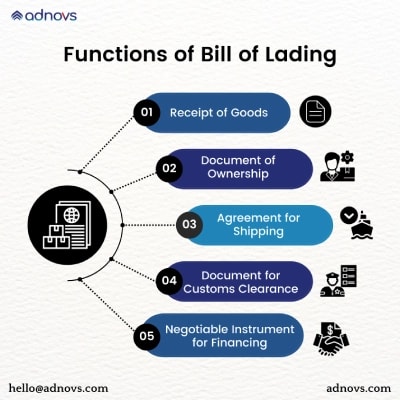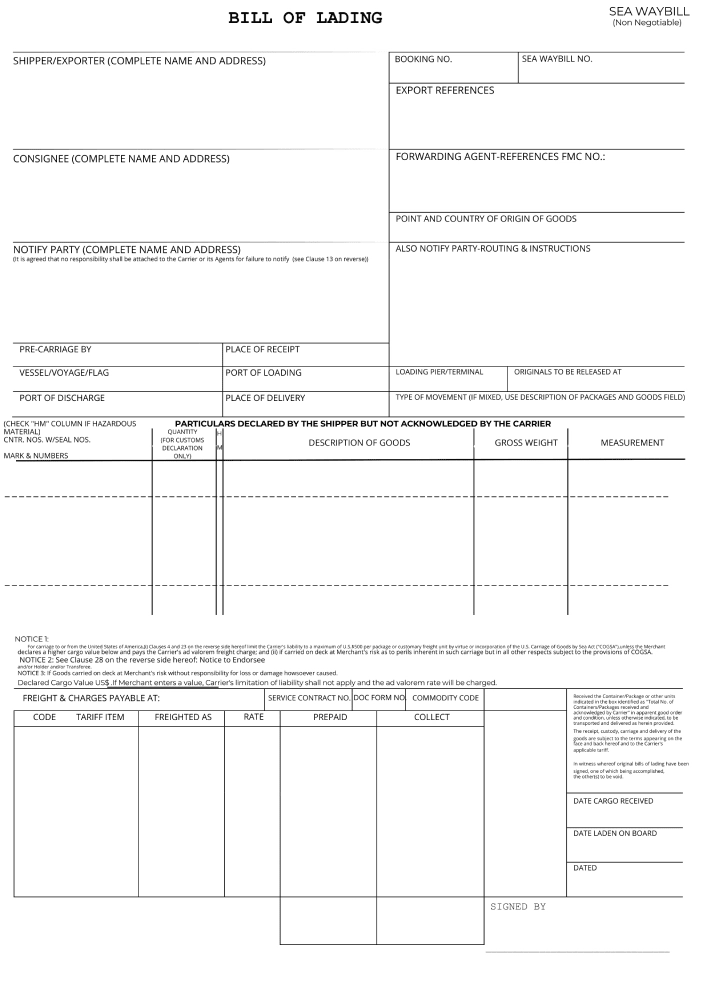5 Functions of Bill of Lading
5 Functions of Bill of Lading
What is a Bill of lading (BoL or B\L)?
The Bill of lading is the main document in logistics. It contains all the shipment information including the supplier and vendor details, about transporting vessel, departure times, and more, serving as a comprehensive record of the shipment. It is provided by the carrier or the shipping company transporting the goods.
5 Functions of Bill of Lading
A bill of lading (B/L) has several functions in logistics and shipping. The 5 main functions of a bill of lading are listed below,

1. Receipt of Goods:
Act as a confirmation that the carrier has received the goods specified in the document. This helps in settling disputes over the condition of goods or quantity during shipment.
2. Document of Ownership:
Act as a certificate that represents the ownership of goods during shipment.
This depends on the factor that the B\L is negotiable or non-negotiable.
If Non-Negotiable, Ownership is with the consignee stated on the Bill of Lading.
If Negotiable, Ownership can be transferred through endorsement, allowing for multiple parties to have ownership rights during transit, with the final endorsee having the right to claim the goods.
3. Agreement for Shipping:
Act as a contract/agreement between the shipper and the carrier for shipping.
It includes all the terms and conditions to be followed during shipment.
4. Document for Customs Clearance:
Provide all the necessary information for customs clearance at the port of origin and destination.
Customs brokers check the details like the nature, value, and quantity mentioned in the B\L for issuing duties and taxes and ensuring compliance with trade regulations.
5. Negotiable Instrument for Financing:
Acts as a negotiable instrument in financial transactions if it’s Negotiable B\L.
They can be used as collateral for getting loans from banks and help in the letter of credit process ensuring a secure payment process between the buyer and seller.
What are the details provided in the Bill of lading?

- Shipper details: Name and address of supplier/exporter/seller.
- Consignee details: Name and address of importer/buyer/recipient.
- Carrier details: Name and details of the carrier assigned for shipment.
- Vessel Details: If goods are transported by sea, the Name of the vessel
- Port details: The name port of origin and destination.
- Type of Bill of Lading: Specifies whether the Bill of Lading is negotiable or non-negotiable.
- Bill of Lading Number and Booking Number: A unique number is assigned to the Bill of Lading for tracking and reference purposes.
- Export References: Contains reference number and inquiry number which facilitates tracking, communication, and management of the shipping process.
- Type of movement: Specifies the type of movement like FCL or LCL
- Shipping Marks and Numbers: Unique marks and numbers of shipping containers that help in tracking and identification purposes.
- Goods details: Details about the goods, including quantity, description, weight, volume, etc.
- Packaging Information: Information on what type of packaging is used for the goods like boxes, crates, or containers.
- Freight and Charges: Details about the freight charges and any additional charges associated with the shipment.
- Routing Instructions: Instructions to the carrier on which route to use for shipping to the port of destination.
- Date of Shipment: Mention when the goods are loaded onto the carrier.
- Terms and Conditions: The terms and conditions between the shipper and the carrier.
- Signature and Stamp: The signature of the carrier or its agent, acknowledging the receipt.
- Special Instructions: Special instructions or remarks related to handling or delivering goods.
- Documentary Credits or Letter of Credit Information (if any): Information related to documentary credits or Letters of Credit associated with the shipment.
Different types of bills of lading

